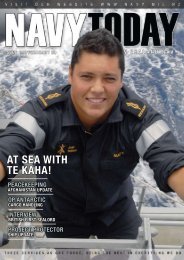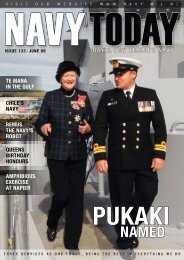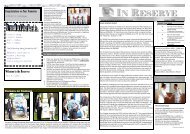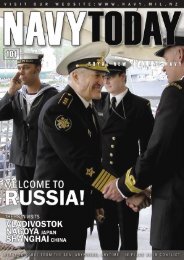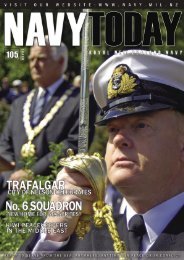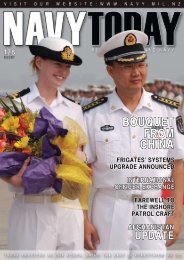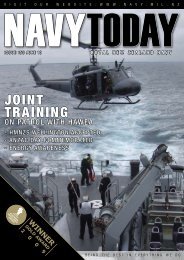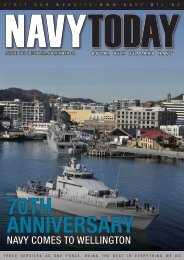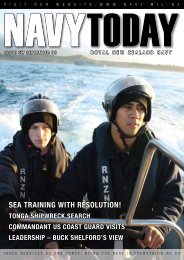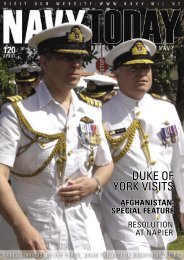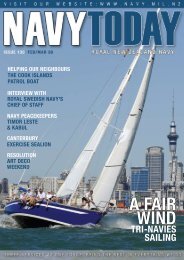CANTERBURY! HMNZS - Royal New Zealand Navy
CANTERBURY! HMNZS - Royal New Zealand Navy
CANTERBURY! HMNZS - Royal New Zealand Navy
- No tags were found...
Create successful ePaper yourself
Turn your PDF publications into a flip-book with our unique Google optimized e-Paper software.
NZDF OPERATIONSThe Queen has been pleased to approve thefollowing <strong>New</strong> <strong>Zealand</strong> Gallantry Awards:• Victoria Cross for <strong>New</strong> <strong>Zealand</strong> (VC) to Corporal Bill HenryApiata, 1st <strong>New</strong> <strong>Zealand</strong> Special Air Service Group; CPLApiata is from Northland and Te Kaha in the eastern Bay of Plenty.• The <strong>New</strong> <strong>Zealand</strong> Gallantry Decoration for two members of the 1stNZSAS.• The <strong>New</strong> <strong>Zealand</strong> Gallantry Medal to one member of the 1st NZSAS.For security reasons, the names of the recipients of the two NZ GallantryDecorations and the NZ Gallantry Medal will not be released.CDF said that ‘This announcement is an incredibly proud moment for <strong>New</strong><strong>Zealand</strong>, the NZDF and the NZSAS. All four recipients have shown incrediblestrength of character in adverse conditions and embody the ethos and valuesof the <strong>New</strong> <strong>Zealand</strong> Defence Force. I congratulate Corporal Apiata and theother three recipients on these most prestigious awards.’VICTORIA CROSS AWARDEDTO NZSAS TROOPERLANCE Corporal (now Corporal) Apiata was,in 2004, part of an NZSAS Troop on patrol inAfghanistan, which laid up in defensive formationfor the night. At approximately 0315hours, the Troop was attacked by a groupof about twenty enemy fighters, who hadapproached by stealth using the cover ofundulating ground in pitch darkness. Rocketpropelledgrenades struck two of the Troop’svehicles, destroying one and immobilisingthe other. The opening strike was followedby dense and persistent machine gun andautomatic rifle fire from close range. Theattack then continued using further rocketpropelledgrenades and machine gun andrifle fire. The initial attack was directed atthe vehicle where LCPL Apiata was stationed.He was blown off the bonnet by theimpact of rocket propelled grenades strikingthe vehicle. He was dazed, but was notphysically injured. The two other vehicle crewmembers had been wounded by shrapnel;one of them; CPL A, was in a serious condition.Illuminated by the burning vehicle, andunder sustained and accurate enemy firedirected at and around their position, thethree soldiers immediately took what littlecover was available. CPL A was discovered tohave sustained life-threatening wounds. Theother two soldiers immediately began ap-plying basic first aid. LCPL Apiata assumedcommand of the situation, as he could seethat his superior’s condition was deterioratingrapidly. By this time, however, LCPLApiata’s exposed position, some seventymetres in front of the rest of the Troop, wascoming under increasingly intense enemyfire. CPL A was now suffering serious arterialbleeding and was lapsing in and out ofconsciousness.LCPL Apiata concluded that his comradeurgently required medical attention, or hewould likely die. Pinned down by the enemy,in the direct line of fire between friend andfoe, he also judged that there was almost nochance of such help reaching their position.As the enemy pressed their attack towardsLCPL Apiata’s position, and without thoughtof abandoning his colleague to save himself,he took a decision in the highest order ofpersonal courage under fire. Knowing therisks involved in moving to open ground,LCPL Apiata decided to carry CPL A singlehandedlyto the relative safety of the mainTroop position, which afforded better coverand where medical treatment could be given.He ordered his other colleague, Trooper T tomake his own way back to the rear.In total disregard of his own safety, LCPLApiata stood up and lifted his comrade bodily.He then carried him across the seventy metresof broken, rocky and fire swept ground,fully exposed in the glare of battle to heavyenemy fire and into the face of returning firefrom the main Troop position. That neitherhe nor his colleague were hit is scarcelypossible.Having delivered his wounded companionto relative shelter with the remainder of thepatrol, LCPL Apiata re-armed himself andrejoined the fight in counter-attack. By his actions,he removed the tactical complicationsof CPL A’s predicament from considerationsof rescue.The Troop could now concentrate entirelyon prevailing in the battle itself. After anengagement lasting approximately twentyminutes, the assault was broken up and thenumerically superior attackers were routedwith significant casualties, with the Troopin pursuit.LCPL Apiata had thereby contributed materiallyto the operational success of theengagement. A subsequent medical assessmentconfirmed that CPL A would probablyhave died of blood loss and shock, had it notbeen for LCPL Apiata’s selflessly courageousact in carrying him back to the main Trooplines, to receive the immediate treatmentthat he needed.THE VICTORIA CROSSTHE Victoria Cross (VC) was created byQueen Victoria in 1856 to recognise acts ofgallantry in the presence of the enemy bymembers of the armed forces, regardless ofrank. It enjoys precedence before all otherhonours and awards.<strong>New</strong> <strong>Zealand</strong> is not the only Commonwealthcountry to have retained the VC as itssenior gallantry award. In 1991 the Queenof Australia instituted the ‘Victoria Cross forAustralia’, and in 1993 the Queen of Canadainstituted the ‘Victoria Cross for Canada’.The <strong>New</strong> <strong>Zealand</strong> and Australian crosses areidentical in both design and metal compositionto the British cross.The VC has been awarded 1,356 timessince 1856. Since the end of WWII, the VChad been awarded only 13 times:• The Korean War, 1950-53 (Four British recipients,two posthumous)• Confrontation with Indonesian forces inBorneo, 1966 (One British recipient)• The Vietnam War, 1965-69 (Four Australianrecipients, two posthumous),• The Falklands War, 1982 (Two British re-THE 1995 Prime Minister’s Honours AdvisoryCommittee recommended the discontinuanceof British awards for gallantry and braveryand the institution of a series of distinctive<strong>New</strong> <strong>Zealand</strong> awards. The governmentaccepted the committee recommendationthat the Victoria Cross (VC) should remain<strong>New</strong> <strong>Zealand</strong>’s highest award for acts of gallantryin war and for war-like operations.The <strong>New</strong> <strong>Zealand</strong> Gallantry Awards aredesigned to recognise those military, andcertain other categories of support personnel,who perform acts of gallantry whileinvolved in war and warlike operationalservice (including peacekeeping). Gallantryawards do not necessarily involvethe saving or attempting to save the life ofanother person.The four Gallantry Awards, instituted by a<strong>New</strong> <strong>Zealand</strong> <strong>Royal</strong> Warrant dated 20 September1999, are:• The Victoria Cross for <strong>New</strong> <strong>Zealand</strong> (VC)“For most conspicuous gallantry, or somecipients, both posthumous)• Iraq, 2004 (One British recipient)• Afghanistan, 2006 (One British recipient,posthumous).Corporal Apiata becomes the 14th recipientand the first Commonwealth recipientsince Australian Warrant Officer Keith Paynereceived the award in 1969.The VC has been awarded to 22 <strong>New</strong> <strong>Zealand</strong>military personnel since 1864 (includingCPL Apiata).There are at present only 13 living VC recipientsworldwide, including CPL Apiata.LCPL Johnson Beharry of the Princess ofWales’s <strong>Royal</strong> Regiment, British Army, whoreceived his award for gallantry in Iraq in2004, is the only other recipient still servingin the military.The VC is cast in gunmetal from gunscaptured from the Russian Army during theCrimean War. The metal is chemically treatedto give a dark bronze finish. The rank, name,and unit of service of the recipient is engravedon the reverse of the suspender barand the date of the act or acts for which theTHE NEW ZEALAND GALLANTRY AWARDSdaring or pre-eminent act of valour or selfsacrifice or extreme devotion to duty in thepresence of the enemy or of belligerents”• The <strong>New</strong> <strong>Zealand</strong> Gallantry Star (NZGS)“For acts of outstanding gallantry in situationsof danger”• The <strong>New</strong> <strong>Zealand</strong> Gallantry Decoration(NZGD)“For acts of exceptional gallantry in situationsof danger”• The <strong>New</strong> <strong>Zealand</strong> Gallantry Medal (NZGM)“For acts of gallantry”There are also four <strong>New</strong> <strong>Zealand</strong> BraveryAwards (the <strong>New</strong> <strong>Zealand</strong> Cross, the <strong>New</strong><strong>Zealand</strong> Bravery Star, the <strong>New</strong> <strong>Zealand</strong>Bravery Decoration, and the <strong>New</strong> <strong>Zealand</strong>Bravery Medal) that are primarily designedfor civilians who put their lives at risk whilesaving or attempting to save the life of anotherperson.They may be awarded to military personnelwhere a gallantry award is not consideredappropriate.Cross is awarded is engraved on the centralportion of the reverse. The Victoria Cross for<strong>New</strong> <strong>Zealand</strong> is manufactured by the Londonjewellers Hancock and Co, who have madethe VC since its inception.For further information see: In the Face of theEnemy by Glyn Harper and Colin Richardson,published by Harper Collins in 2006.CLOCKWISE FROM TOP LEFT: The VictoriaCross for <strong>New</strong> <strong>Zealand</strong> (VC); The <strong>New</strong> <strong>Zealand</strong>Gallantry Star (NZGS); The <strong>New</strong> <strong>Zealand</strong>Gallantry Medal (NZGM); The <strong>New</strong> <strong>Zealand</strong>Gallantry Decoration (NZGD)4 NT123JULY07 WWW.NAVY.MIL.NZWWW.NAVY.MIL.NZNT123JULY07 5



